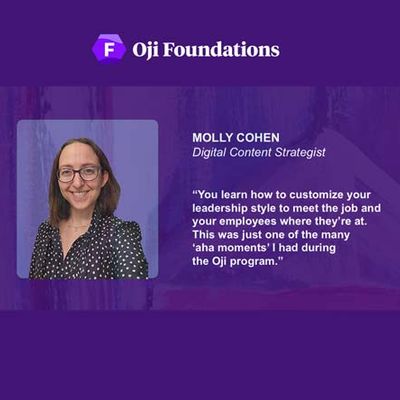Strategies that Work: Managing Emotions in the Workplace

Whether we go to work in a downtown skyscraper or on a laptop flipped open on the dining room table, we bring our emotions with us. Organizational culture often promotes the myth that emotions can and should be left at the door but emotions, whether useful to the mission or not, are always present.
The pandemic has only exacerbated people’s emotional swings, especially in unhelpful directions. The result: it’s more important than ever for professionals to develop their emotional intelligence (EI) at work.
The good news is that the skills of emotional intelligence enable us to recognize and regulate emotions to better serve us whether your colleagues see you as even-keeled, excitable, overly chill or downright abrasive. Navigating emotions in the workplace is key to individual and organizational success and the bottom line.
EI lets you understand the dynamics that are in play, and that everyone in your organization has a complex emotional life that you’ll never fully comprehend.
So how can you begin to develop emotional skills? In order to regulate your feelings, you must first recognize what it is you're feeling.
Recognizing and understanding your emotions at work
Everyone can think of someone who has low EI, someone who’s unaware of their own emotional states as they ebb and flow. In a way, it’s not surprising that this “emotion blindness” is so common, because it can be difficult to put a name on your emotions if you’re not in the habit of observing them. It’s also challenging if we have a limited vocabulary; many professionals I work with only have a few words to describe how they are feeling (like mad, glad or sad). As we say, you need to “name it to tame it”, so recognizing and naming your emotions are essential skills.
To give you an example of the impact emotions can play in driving team culture, I want to share a story about an executive we’ll call Bill. As a senior vice president at an auto manufacturer, Bill took the first step in building his emotional intelligence at work by recognizing that he was spending most of each work day feeling anxious or angry – emotional states that are high energy and also highly unpleasant. He also observed that his unpleasant emotions were affecting people who worked for him; his anxiety was contagious. He was disturbed by the realization that he was bringing down the team.
To his credit, the executive set out to improve the situation. “I don’t like feeling this way,” he said. “And I don’t want to make others feel this way.” His top reason for wanting to better regulate his own emotions was to benefit the people who worked for him and the mission they shared. He was able to change for the better by developing emotional skills, asking himself questions such as:
- Can I identify what I’m feeling as I experience it?
- Can I label my emotions accurately?
- Do I understand their root causes?
- How accurately do I interpret the emotions of others?
- How do I know my interpretation is accurate?
How you can regulate emotions in the workplace
Once you recognize and begin to understand the emotions that you’re feeling, the next step is to learn how to regulate them. When you apply techniques to shift from unhelpful emotions to productive ones, you begin to manage your emotions for the good of yourself, your team, and your entire organization.
So how can leaders, managers and staff regulate their emotions to drive better outcomes? As you know from developing other skills, learning how to apply emotional intelligence skills to everyday situations, in real time, isn't something that occurs as the result of reading a brief article (even this one!). That said, let’s take a look at some basic steps that can help anyone at any level of the organization to regulate their emotions when they’ve become unruly and unhelpful.
- Take a breath. Deliberately taking a slow breath helps to calm your nervous system.
- Name it to tame it. Just by labeling a feeling, you’ll begin to loosen its grip on you.
- Find the root cause. Tracing the reason you feel this way increases your odds of making a positive change.
- Pick a regulation strategy and use it. Try feeling your feet in your shoes or imagining your best self.
- Reflect. Think about what brought you to the point of needing to regulate your emotions.
- Learn and apply. Pay attention to which regulation strategies work best for you and use them when needed. No one strategy works all of the time, so build a toolkit of strategies that will support you in a variety of circumstances.
We’ve seen this checklist work for a vice president of engineering who was anxious about an upcoming meeting on a very contentious topic. Recognizing his emotions, he chose to regulate them by planning positive steps that would make him feel calm and grounded and ensure the best outcome.
The VP planned a nice lunch for the meeting day and blocked out time for a walk outside. When he opened the meeting, he was in a much better mood and succeeded in bringing the group to consensus, an important outcome for the business.
The power of emotional intelligence is that the VP produced a better outcome just by changing himself and no one else. He was able to show up differently for the meeting because he was aware of his feelings and applied strategies to regulate them. And he was better able to navigate conversations with his team. In reflection, he shared, “I know that I won’t always get the outcome I want every time, but I absolutely know that I wouldn’t have achieved it in this case if I hadn’t regulated my emotions before and during the meeting.”
Regulation strategies for leaders
More than anyone else in the organization, leaders must consider how their emotions affect others. Here are just a few of the simpler techniques that can help leaders navigate their emotional intelligence challenges.
Be aware of your own emotions and how they change through the day.
When you feel an emotion that’s not helpful for the task at hand, use a strategy to shift to a more useful emotion:
- Go outside
- Make a cup of tea
- Work in a different room if possible
- Listen to music that’s calming or uplifting
Observe and ask about the emotions of the people who work for you.
Here are some ways of bringing up the topic skillfully:
- “You seem quiet today. Is everything OK?”
- “How are you feeling about this project and the deadline we’re facing?”
- “How are things going for you this week?”
- “What’s something you feel good about right now?”
- “What frustrations are you quietly navigating that would be useful to get out in the open?"
Once you know how a team member is feeling, demonstrate care and concern by listening and taking actions that improve their work experience.
Taking these steps and repeating them often builds a culture of trust and encourages open communication. Leaders succeed when they remember to listen more than they talk, and to lead by example by sharing their emotions. Authentic leaders aren’t happy all of the time, nor do they have all of the answers. But they do express their emotions in a way that’s situationally appropriate.
It’s difficult to overemphasize the importance of managing emotions in the workplace. The good news is that emotional intelligence at work can be learned, with practice, over time. Start by checking on how you feel 3 - 5 times during your work day. Ask yourself: is it useful to stay feeling this way, or better to shift? If it’s better to shift, what would I like to feel instead? Then, pick a strategy that helps to move you from one emotion to the other. The more you put these techniques into practice, the better prepared you will be - especially during high stakes situations.
Of course, you'll find it easier to apply these new skills if you can find ways to practice and get input from a coach and your peers. The more you put these techniques into practice, the better prepared you will be - especially during high stakes situations.
Master the skills needed to raise your emotional intelligence. Speak with an Oji Emotions Specialist today
Latest Posts
BACK TO HOME ❯Sign up for our People-Powered Newsletter.

 Meet our Program Experts
Meet our Program Experts
 Why Oji is Different
Why Oji is Different
 First Impressions of the Oji Foundations Program
First Impressions of the Oji Foundations Program